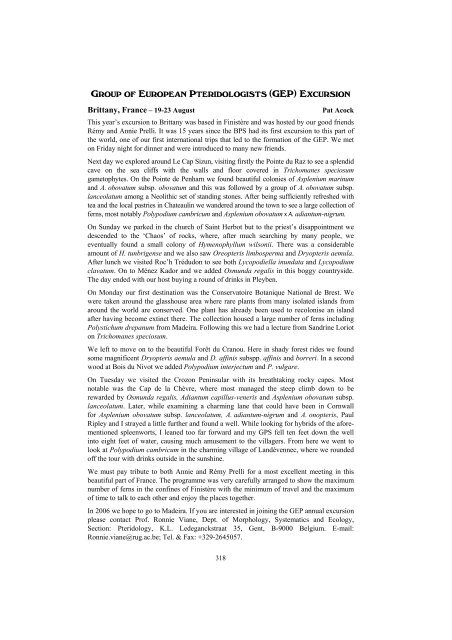REGIONAL MEETINGS - Natural History Museum
REGIONAL MEETINGS - Natural History Museum
REGIONAL MEETINGS - Natural History Museum
You also want an ePaper? Increase the reach of your titles
YUMPU automatically turns print PDFs into web optimized ePapers that Google loves.
GROUP OF EUROPEAN PTERIDOLOGISTS (GEP) EXCURSION<br />
Brittany, France – 19-23 August Pat Acock<br />
This year’s excursion to Brittany was based in Finistère and was hosted by our good friends<br />
Rémy and Annie Prelli. It was 15 years since the BPS had its first excursion to this part of<br />
the world, one of our first international trips that led to the formation of the GEP. We met<br />
on Friday night for dinner and were introduced to many new friends.<br />
Next day we explored around Le Cap Sizun, visiting firstly the Pointe du Raz to see a splendid<br />
cave on the sea cliffs with the walls and floor covered in Trichomanes speciosum<br />
gametophytes. On the Pointe de Penharn we found beautiful colonies of Asplenium marinum<br />
and A. obovatum subsp. obovatum and this was followed by a group of A. obovatum subsp.<br />
lanceolatum among a Neolithic set of standing stones. After being sufficiently refreshed with<br />
tea and the local pastries in Chateaulin we wandered around the town to see a large collection of<br />
ferns, most notably Polypodium cambricum and Asplenium obovatum x A. adiantum-nigrum.<br />
On Sunday we parked in the church of Saint Herbot but to the priest’s disappointment we<br />
descended to the ‘Chaos’ of rocks, where, after much searching by many people, we<br />
eventually found a small colony of Hymenophyllum wilsonii. There was a considerable<br />
amount of H. tunbrigense and we also saw Oreopteris limbosperma and Dryopteris aemula.<br />
After lunch we visited Roc’h Trédudon to see both Lycopodiella inundata and Lycopodium<br />
clavatum. On to Ménez Kador and we added Osmunda regalis in this boggy countryside.<br />
The day ended with our host buying a round of drinks in Pleyben.<br />
On Monday our first destination was the Conservatoire Botanique National de Brest. We<br />
were taken around the glasshouse area where rare plants from many isolated islands from<br />
around the world are conserved. One plant has already been used to recolonise an island<br />
after having become extinct there. The collection housed a large number of ferns including<br />
Polystichum drepanum from Madeira. Following this we had a lecture from Sandrine Loriot<br />
on Trichomanes speciosum.<br />
We left to move on to the beautiful Forêt du Cranou. Here in shady forest rides we found<br />
some magnificent Dryopteris aemula and D. affinis subspp. affinis and borreri. In a second<br />
wood at Bois du Nivot we added Polypodium interjectum and P. vulgare.<br />
On Tuesday we visited the Crozon Peninsular with its breathtaking rocky capes. Most<br />
notable was the Cap de la Chèvre, where most managed the steep climb down to be<br />
rewarded by Osmunda regalis, Adiantum capillus-veneris and Asplenium obovatum subsp.<br />
lanceolatum. Later, while examining a charming lane that could have been in Cornwall<br />
for Asplenium obovatum subsp. lanceolatum, A. adiantum-nigrum and A. onopteris, Paul<br />
Ripley and I strayed a little further and found a well. While looking for hybrids of the aforementioned<br />
spleenworts, I leaned too far forward and my GPS fell ten feet down the well<br />
into eight feet of water, causing much amusement to the villagers. From here we went to<br />
look at Polypodium cambricum in the charming village of Landévennec, where we rounded<br />
off the tour with drinks outside in the sunshine.<br />
We must pay tribute to both Annie and Rémy Prelli for a most excellent meeting in this<br />
beautiful part of France. The programme was very carefully arranged to show the maximum<br />
number of ferns in the confines of Finistère with the minimum of travel and the maximum<br />
of time to talk to each other and enjoy the places together.<br />
In 2006 we hope to go to Madeira. If you are interested in joining the GEP annual excursion<br />
please contact Prof. Ronnie Viane, Dept. of Morphology, Systematics and Ecology,<br />
Section: Pteridology, K.L. Ledeganckstraat 35, Gent, B-9000 Belgium. E-mail:<br />
Ronnie.viane@rug.ac.be; Tel. & Fax: +329-2645057.<br />
318
















